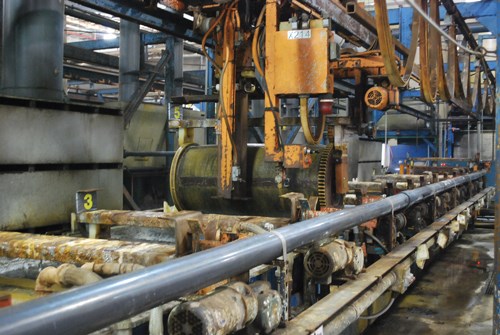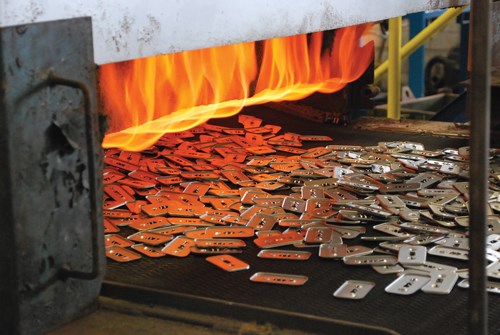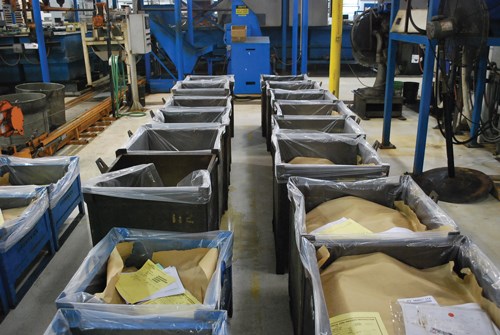Coating by the Billions
A Raymond Tinnerman coats automotive parts fasteners and clips … a lot of them
There are no golden arches sitting outside the A Raymond Tinnerman manufacturing and finishing plant in Logansport, Ind., but the company does have a lot in common with the makers of the Big Macs.
Each year they make and finish about a billion clips and fasteners, nearly all for the automotive sector in North America.
“It’s a lot,” says Vince Rhodes, the company’s Logansport plant finishing superintendent, who has been running the lines for more than 30 years.
About 70 million fasteners are stamped, folded, cut and finished each month at the Logansport plant alone; the plating and finishing lines also do the same work for other A Raymond Tinnerman plants in the U.S., making them one of the largest fastener makers in the world.
The Logansport location has two paint coating lines and four different types of plating lines. The uptick in the automotive market in the past few years has been great for A Raymond Tinnerman, Rhodes says, although the work is cyclical depending on how well the car makers can sell the vehicles.
“We’re at three shifts a day now, so it’s going pretty well,” says Rhodes. “It may start to slow down some, but it keeps us very busy right now.”
Global Firm
One of the best things going for the company is its globalization. In addition to finishing, the firm has plastic injection molding, metal forming and automotive assembly operations in the U.S. and around the world, serving automakers in Germany, Brazil, China, the U.S. and more.
The A Raymond Tinnerman company is a 2009 merger of the Tinnerman Co.—founded in Cleveland in 1870 by George Tinnerman—and the A Raymond company begun in France in 1865 by Albert-Pierre Raymond.
George Tinnerman’s company was originally known as the Tinnerman Stove Co., and in 1936 George’s son, Albert, created a spring steel fastener known as the Speed Nut that was used when shipping their high-end stoves across the U.S.
Eventually, the founder’s grandson—also named George—commercialized Speed Nuts in markets beyond stoves, such as the emerging automotive sector and the aerospace industry. They were so successful that the Tinnermans closed the stove business entirely and focused solely on fasteners, and now boast that they became the supplier of fasteners for 100 percent of all aircraft built during World War II.
The Tinnerman products revolutionized the automotive industry because their now world-renowned fasteners held parts in place without the need for welding or riveting. At the time, many in the automotive industry doubted whether the fasteners were strong enough to permanently hold parts together, such as a fender to a car body.
That fear was put to rest, according to a 1947 Fortune magazine article on Tinnerman, when the company invited executives from the largest car makers to watch a display where they hoisted a 3,325-pound Chrysler off the ground with only the use of a Speed Nut holding its weight.
Deal with Ford
A few years later, the Tinnerman group demonstrated to Henry Ford that they could save him millions of dollars each year by changing the way his assembly line attached parts, including pointing out 400 different instances on a car where their fasteners could do the trick faster and cheaper.
The A Raymond company, meanwhile, made fasteners and clips for the glove, shoe, leather, textile, radio, construction and automotive industries. Today, the company holds 1,000 industrial patents in fasteners, clips and springs, including a variation of the zipper invented in 1925 that also revolutionized an industry, but this one in fashion and clothing.
A Raymond moved into the automotive sector in the 1930s to offer clips to carmakers, and slowly grew the company to expand into shipbuilding and then into plastic injection fasteners for the automotive and appliance market.
But it wasn’t until the company developed a business strategy in 2008 to become more global in its products by going after markets such as industrial equipment, building, energies, agriculture and pharmaceutical, that it crossed paths with the Tinnerman Co.
In 2009, the A Raymond and Tinnerman companies—the latter had been supplying the former with fasteners for several years—came together to form an industry leader in clip fasteners and associated assembly technologies that service the automotive field.
“We’re creating a powerful, new North American organization to provide our customers with a better, more competitive and complete portfolio of plastic and metal fasteners, fluid quick-connectors and other assemblies,” said Earl Brown, president of A Raymond Tinnerman.
21 Countries
Tinnerman has about 400 employees at facilities in Brunswick, Ohio; Flemingsburg, Ky.; Logansport, Ind.; Southfield, Mich., and Hamilton, Ontario, Canada. At the time of merger, A Raymond had more than 100 employees in the U.S. at two manufacturing plants in the Detroit suburb Rochester Hills.
In total, the two companies now have 5,200 employees working in 21 countries around the world in manufacturing, engineering and sales.
The Logansport operation is focused mostly on barrel plating and dip-spin coatings, processes which lead to their own challenges, especially in the barrel approach.
“You can get a lot of problems of parts sticking together and nesting,” Rhodes says. “But we salt-spray test daily to make sure what we are sending to our customers is going to hold up in their product. It’s an ongoing challenge.”
Luckily for A Raymond Tinnerman, Rhodes has a good relationship with his chemical supplier, Charlotte, N.C.-based Pavco, and the company’s regional rep, Brian Greene, who works for Plating Specialist Inc., with an office near Tinnerman’s plant.
Although Greene makes it a habit to stop by and check the zinc plating lines every Friday, he commends the Tinnerman plating staff and Rhodes for maintaining one of the best organized and meticulous plating operations he’s seen.
“They do it right,” says Greene. “And that isn’t easy, especially in barrel plating. But Vince and his staff do an outstanding job on their chemical maintenance. It’s important for them, and they know what they are doing. Tinnerman’s knowledge and work ethic produces a successful, well-run operation.”
Zinc Line
A Raymond Tinnerman uses Pavco’s SmartZinc line of chemistries, which can significantly reduce the zinc deposition ratio from the high to low current density. Greene says the product, a two-component, low-ammonia, high-temperature zinc plating system, can increase deposition in the low current density up to 75 percent, and increases plating speed by as much as 30 percent.
Most platers like the SmartZinc product, Greene says, because of ease of control, consistent day to day operation, extreme high temperature tolerance and good chromate receptivity.
But Rhodes and Greene know that barrel plating isn’t a walk in the park, no matter how consistent the chemical bath is set up to run. So knowing what you’re doing makes it a fairly simple process.
“At times, barrel plating can be easier than rack plating because the current density differences are much smaller in-barrel,” Greene says. “In-barrel, it’s usually 5-7 amps per square foot, whereas rack can vary from 15-40 amps.”
Greene says the bath chemistry of a barrel operation can be easily controlled due to consistent loading, predictable dragout and a smaller, stable operating range.
Pavco started working with A Raymond Tinnerman about a decade ago, and quickly fine-tuned the company’s plating lines to become a more efficient operation, helping with all aspects, including the cleaners to the zinc to the passivation process.
20% More Efficient
Soon, the A Raymond Tinnerman line was running about 20 percent more product through the plating lines and reaping the benefits of the more efficient operation.
“We can put more products in the barrel and plate at a higher current than they had been, all without burning the parts,” Greene says.
Rhodes challenge is meeting demanding specifications of A Raymond Tinnerman’s customers, who almost all seem to have different specs based off of the big automakers.
“The most difficult part of the process is quoting a spec, and then two years down the road that spec may get changed by Ford or another automaker, and we need the ability to stay on top of those ever-changing requirements,” Rhodes says.
Earlier in 2013, A Raymond Tinnerman launched a truck segment, hoping its proven expertise on installation and assembly solutions would pave the way for new “smart techniques” that could be adapted to the needs of truck manufacturers.
Product Standardization
The company says priority will be given to product standardization—clips and quick connectors—with the aim of simplifying processes, making parts lighter and reducing costs. Driven by the urge to break into this demanding market, A Raymond Tinnerman officials says they have developed various applications for internal and external fittings, including clips and quick connectors adapted to the full range of manufacturer needs, especially those in heavy goods, utility, farm or construction machinery.
The Logansport location recently added a mechanical zinc plating line for a Ford line of fasteners, and is now approved for ZinKlad 250M by MacDermid Enthone. Previously, A Raymond Tinnerman sent the work out to be zinc plated, but purchased a used line to keep control of the process.
“When you start looking at the numbers and see how much you are spending in trucking and other costs, then you can start looking at how you can justify bringing it all inside,” says Rhodes. “It’s the same with ecoat; we don’t have a lot of it, but if we did, we would look at bringing that inside, too.”
Rhodes worked with Tom Rochester at Plating Systems and Technologies in Jackson, Mich., to purchase and install the zinc plating equipment. Tinnerman then worked with MacDermid to get certified for the Ford coating application.
“Working with Tom Rochester and his company really helped us get this line up quickly,” Rhodes says. “Tom knows his stuff. He helped us get the line up, and got our feet wet running it before we went to MacDermid, so we were ready.”
Part of the process for MacDermid certification is a quarterly inspection that usually takes half a day, where bath record and salt spray tests are examined and reviewed.
But Rhodes and his staff at A Raymond Tinnerman always seem to be prepared, whether it is plating just a few parts for an outside customer, or a billion fasteners and clips for the biggest automakers in the world.
“Every part we coat we take great pride in,” Rhodes says.
These days, that’s a lot of pride in Logansport.
For Information on A Raymond Tinnerman, please visit araymondtinnerman.com; visit Pavco, Inc. at Pavco.com; MacDermind at Macdermid.com; Plating Systems and Technologies at mechanicalplating.com
LEARN MORE
Measuring the Surface Area of Fasteners
How do you measure the surface area of a threaded fastener? How much coating would you put on it? How thick of a coating? The U.S. Department of Agriculture’s Forest Service has come up with the solution for those pondering these questions.
pfonline.com/articles/measuring-the-surface-area-of-fasteners
Related Content
Anodizing for Bonding Applications in Aerospace
Anodizing for pre-prep bonding bridges the gap between metallic and composite worlds, as it provides a superior surface in many applications on aluminum components for bonding to these composites.
Read MoreTop Shop Aces Outstanding Customer Service
More than a finishing shop, this anodizing, powder coating and vacuum resin impregnating business goes above and beyond for its customers by being a resource for whatever their finishing needs might demand.
Read MoreUnderstanding and Managing White Spots on Anodized Aluminum
Having trouble with spotting defects when anodizing? Taj Patel of Techevon LLC offers a helpful overview of the various causes of white spots and potential solutions.
Read More10 Anodizing Best Practices
Following this list of guidelines can help to increase the performance, cost effectiveness and quality for your anodizing operation.
Read MoreRead Next
Measuring the Surface Area of Fasteners
How do you measure the surface area of a threaded fastener? How much coating would you put on it? How thick of a coating? What about non-threaded fasteners? The U.S. Department of Agriculture’s Forest Service, of all people, may have come up with the solution for those pondering how to coat sometimes-difficult small pieces using computer imaging and software to compute the area.
Read MoreEducation Bringing Cleaning to Machining
Debuting new speakers and cleaning technology content during this half-day workshop co-located with IMTS 2024.
Read MoreEpisode 45: An Interview with Chandler Mancuso, MacDermid Envio Solutions
Chandler Mancuso, technical director with MacDermid Envio discusses updating your wastewater treatment system and implementing materials recycling solutions to increase efficiencies, control costs and reduce environmental impact.
Read More















.jpg;maxWidth=300;quality=90)










